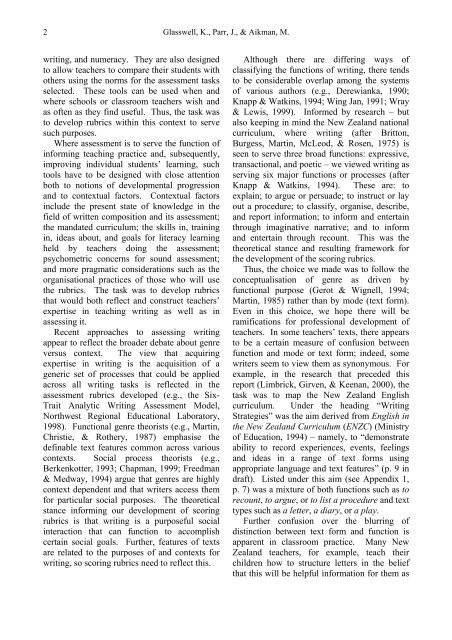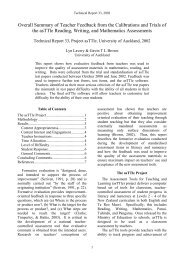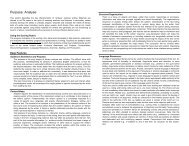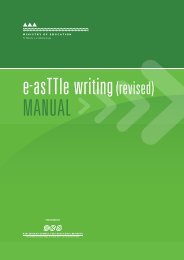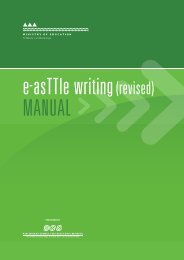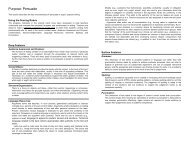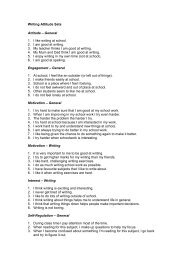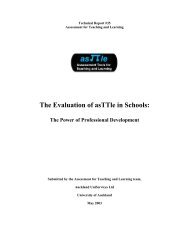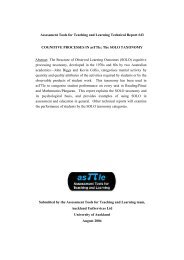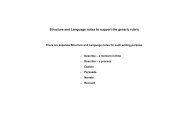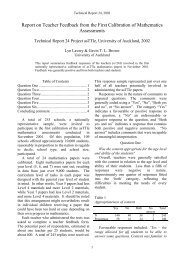Development of the asTTle Writing Assessment Rubrics for Scoring ...
Development of the asTTle Writing Assessment Rubrics for Scoring ...
Development of the asTTle Writing Assessment Rubrics for Scoring ...
- No tags were found...
You also want an ePaper? Increase the reach of your titles
YUMPU automatically turns print PDFs into web optimized ePapers that Google loves.
2 Glasswell, K., Parr, J., & Aikman, M.writing, and numeracy. They are also designedto allow teachers to compare <strong>the</strong>ir students witho<strong>the</strong>rs using <strong>the</strong> norms <strong>for</strong> <strong>the</strong> assessment tasksselected. These tools can be used when andwhere schools or classroom teachers wish andas <strong>of</strong>ten as <strong>the</strong>y find useful. Thus, <strong>the</strong> task wasto develop rubrics within this context to servesuch purposes.Where assessment is to serve <strong>the</strong> function <strong>of</strong>in<strong>for</strong>ming teaching practice and, subsequently,improving individual students’ learning, suchtools have to be designed with close attentionboth to notions <strong>of</strong> developmental progressionand to contextual factors. Contextual factorsinclude <strong>the</strong> present state <strong>of</strong> knowledge in <strong>the</strong>field <strong>of</strong> written composition and its assessment;<strong>the</strong> mandated curriculum; <strong>the</strong> skills in, trainingin, ideas about, and goals <strong>for</strong> literacy learningheld by teachers doing <strong>the</strong> assessment;psychometric concerns <strong>for</strong> sound assessment;and more pragmatic considerations such as <strong>the</strong>organisational practices <strong>of</strong> those who will use<strong>the</strong> rubrics. The task was to develop rubricsthat would both reflect and construct teachers’expertise in teaching writing as well as inassessing it.Recent approaches to assessing writingappear to reflect <strong>the</strong> broader debate about genreversus context. The view that acquiringexpertise in writing is <strong>the</strong> acquisition <strong>of</strong> ageneric set <strong>of</strong> processes that could be appliedacross all writing tasks is reflected in <strong>the</strong>assessment rubrics developed (e.g., <strong>the</strong> Six-Trait Analytic <strong>Writing</strong> <strong>Assessment</strong> Model,Northwest Regional Educational Laboratory,1998). Functional genre <strong>the</strong>orists (e.g., Martin,Christie, & Ro<strong>the</strong>ry, 1987) emphasise <strong>the</strong>definable text features common across variouscontexts. Social process <strong>the</strong>orists (e.g.,Berkenkotter, 1993; Chapman, 1999; Freedman& Medway, 1994) argue that genres are highlycontext dependent and that writers access <strong>the</strong>m<strong>for</strong> particular social purposes. The <strong>the</strong>oreticalstance in<strong>for</strong>ming our development <strong>of</strong> scoringrubrics is that writing is a purposeful socialinteraction that can function to accomplishcertain social goals. Fur<strong>the</strong>r, features <strong>of</strong> textsare related to <strong>the</strong> purposes <strong>of</strong> and contexts <strong>for</strong>writing, so scoring rubrics need to reflect this.Although <strong>the</strong>re are differing ways <strong>of</strong>classifying <strong>the</strong> functions <strong>of</strong> writing, <strong>the</strong>re tendsto be considerable overlap among <strong>the</strong> systems<strong>of</strong> various authors (e.g., Derewianka, 1990;Knapp & Watkins, 1994; Wing Jan, 1991; Wray& Lewis, 1999). In<strong>for</strong>med by research – butalso keeping in mind <strong>the</strong> New Zealand nationalcurriculum, where writing (after Britton,Burgess, Martin, McLeod, & Rosen, 1975) isseen to serve three broad functions: expressive,transactional, and poetic – we viewed writing asserving six major functions or processes (afterKnapp & Watkins, 1994). These are: toexplain; to argue or persuade; to instruct or layout a procedure; to classify, organise, describe,and report in<strong>for</strong>mation; to in<strong>for</strong>m and entertainthrough imaginative narrative; and to in<strong>for</strong>mand entertain through recount. This was <strong>the</strong><strong>the</strong>oretical stance and resulting framework <strong>for</strong><strong>the</strong> development <strong>of</strong> <strong>the</strong> scoring rubrics.Thus, <strong>the</strong> choice we made was to follow <strong>the</strong>conceptualisation <strong>of</strong> genre as driven byfunctional purpose (Gerot & Wignell, 1994;Martin, 1985) ra<strong>the</strong>r than by mode (text <strong>for</strong>m).Even in this choice, we hope <strong>the</strong>re will beramifications <strong>for</strong> pr<strong>of</strong>essional development <strong>of</strong>teachers. In some teachers’ texts, <strong>the</strong>re appearsto be a certain measure <strong>of</strong> confusion betweenfunction and mode or text <strong>for</strong>m; indeed, somewriters seem to view <strong>the</strong>m as synonymous. Forexample, in <strong>the</strong> research that preceded thisreport (Limbrick, Girven, & Keenan, 2000), <strong>the</strong>task was to map <strong>the</strong> New Zealand Englishcurriculum. Under <strong>the</strong> heading “<strong>Writing</strong>Strategies” was <strong>the</strong> aim derived from English in<strong>the</strong> New Zealand Curriculum (ENZC) (Ministry<strong>of</strong> Education, 1994) – namely, to “demonstrateability to record experiences, events, feelingsand ideas in a range <strong>of</strong> text <strong>for</strong>ms usingappropriate language and text features” (p. 9 indraft). Listed under this aim (see Appendix 1,p. 7) was a mixture <strong>of</strong> both functions such as torecount, to argue, or to list a procedure and texttypes such as a letter, a diary, or a play.Fur<strong>the</strong>r confusion over <strong>the</strong> blurring <strong>of</strong>distinction between text <strong>for</strong>m and function isapparent in classroom practice. Many NewZealand teachers, <strong>for</strong> example, teach <strong>the</strong>irchildren how to structure letters in <strong>the</strong> beliefthat this will be helpful in<strong>for</strong>mation <strong>for</strong> <strong>the</strong>m as


